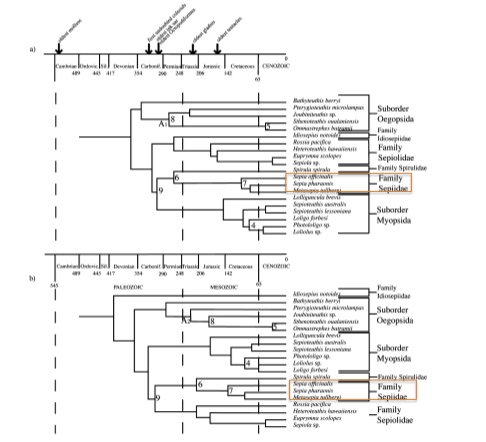Cuttlefish Chromatophores
Biology 342 Fall 2010
Using Polarized Light Reflection and Perception as a Communication Channel
L. Dono and E. Thornquist
Phylogeny
What is Phylogenetics?
Phylogenetics the use of comparitive studies of categorical characteristics and mathematical algorithms to determine evolutionary relatedness—phylogeneticists compare differences and similarities in the morphology (physiology, anatomy, life history, genetics, behavior, etc.) of organisms within and between species to determine their evolutionary relatedness. The study of phylogenetics relies heavily on both the morphological species concept (citation) and the biological species concept (Mayr)
Phylogeny of the Cuttlefish
Cuttlefish belong to the family Sepiidae in the class Cephalopoda which is itself located in phylum Mollusca. That is, cuttlefish are invertebrates, having diverged from other mollusks possibly more than 400 Million years ago (Mya) (citation) and characterized primarily by their bilateral symmetry and a set of arms or tentacles (citation). Most cephalopods have developed the tripartite color changing apparatus of chromatophores, leucophores, and iridophores, and polarized light reflection and perception have been studied in squid as well as cuttlefish (citation, citation).
The position of Sepia on the phylogenetic free and within Cephalopoda is debatable, though recent molecular data have provided evidence that the family shares a strong relationship with Sepiolidae, Myopsida, and Spirulidae (citation, citation, citation).
Figure 1. Phylogenetic tree "for the orders of coleoid cephalopods" with a molecular time scale "based on a mean prior of 400 ± 100 Ma" (Million years ago) for the coleiod root." (a) All three codon positions segregated and considered by codon; (b) only first and second codon positions. Orange boxes surround the family Sepiidae in both trees. Click image for larger version.(Source: Strugnell et al., 2006, emphasis with orange boxes mine)
How did this behavior develop?
Neurally controlled color changing systems have been observed to exist almost exclusively in cephalods, teleosts (silvery fishes), some lizards, and some arthropod shellfish (citation, citation). The evolution of similar color changing systems in non-cephalopod animals appears, however, to be a case of convergent evolution, with the mechanisms behind these evolved characteristics varying greatly amongst the different classes animals (citation). Similarly, as the evolution of these morphological characteristics is homoplastic (evolved independent of evolutionary relationship), then it can be assumed that the possible evolution of communication through polarized light is also an independently derived behavior.
